REFINING COMBAT SEQUENCES OF SPECIALIZED SETS
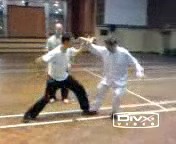
Refining Combat Sequences of Specialized Sets
Why did a kungfu master use a particular pattern and not another pattern, or why a particular pattern in a certain way and not in other ways? It was because that particular pattern in a particular way in a given combat situation gave him certain advantages over his opponent.
Participants to the Special Shaolin Kungfu Course of September 2005 in Malaysia had an experience of this process in kungfu development. They went over the combat sequences they had composed using patterns from their specialized sets. Then Grandmaster Wong helped them to refine their sequences.
Two examples are shown in this video series, one from the sequences composed by Simon and Mark, who are assistant instructors of Shaolin Wahnam England, and the other from the sequences composed by Joshua of Shaolin Wahnam USA and Sifu Tim from Shaolin Wahnam England.
Moving a Step Back for Better Advantage

Simon avoids a “skyward cannon punch” from Mark and applies an arm lock known as “Cross Hand Arm Lock”, which is also a variation of the pattern “Tiger Leaning on Wooden Door”. Sifu Wong explains that moving a step backward first before applying the counter is more advantageous.
Circulating Hand and Moving Forward
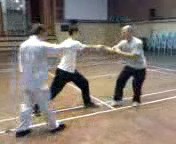
Simon grips Mark's wrist. Mark releases the grip with a palm chop. Sifu Wong explains that it is necessary to turn the wrist before chopping. It is also advantageous to move a step towards the opponent.
Right Positioning for Safety

Sifu Wong explains that Simon must position himself so that he will not be exposed to Mark's counter-strike as he locks Mark's arm.
Subtle Snake Movement to Release Lock
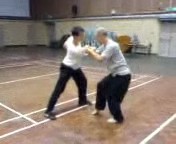
Sifu Wong shows Mark that by means of a subtle snake movement he can release his arm from a seemingly unbreakable arm lock, and counter-strike. Mark and Simon then continue with their sequence composed with patterns from their specialized set, “Dragon-Tiger”.
Securing Advantages in Every Move
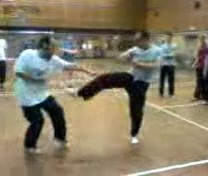
Joshua and Sifu Tim are refining their sequence against a Kick-Boxer. Sifu Wong advises Joshua to strike the opponent's leg at an angle to avoid the possibility of injuring his own knuckles, to hook the opponents arm to minimize his mobility, and to use his leg to control the opponent's leg as he falls.
The Unexpected Tiger-Tail Kick
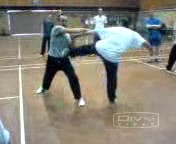
Sifu Tim explains the philosophy for the choice of their patterns in the sequence, and won Sifu Wong's praise. Notice how Joshua controls Sifu Tim's arm, how Sifu Tim releases the control and counter attacks, but is hit unexpectedly by Joshua's Tiger-Tail Kick.
Effective Counters against Kicks
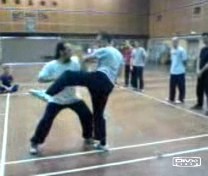
Next Sifu Tim and Joshua show and explain two other sequences they have worked out from their specialized set, “Shaolin Five Animals”. The two sequences incorporate some effective counters against kicks, and won applaud as well as laughter from the other course participants.
Effective Counters against Boxers
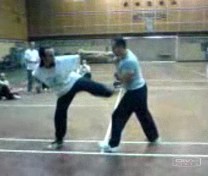
Sifu Tim and Joshua then explains some sequences against Boxers. First Joshua tempts the Boxer to move in, then counter-attacks with a side kick, using the tactic of “long against short”. Next Sifu Tim demonstrates the effective use of the “dragon hand” against Boxers, followed by kicks and felling techniques.
Counters against all the Four Categories of Attacks
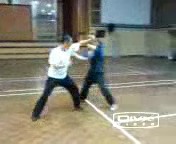
Sifu Tim and Joshua go over the sequences they have worked out. They include all the four categories of attack — striking, kicking, felling and gripping — and their counters. The patterns are taken from their specialized set, “Shaolin Five Animals”.
Understanding Philosophy of Combat Sequences

Sifu Tim and Joshua then provides the philosophy behind the composition of their combat sequences. Understanding the philosophy, among other benefits, enables us to maximize results from minimum effort.
LINKS
Lessons from the Special Shaolin Kungfu Course of September 2005
- Part 1 - Initiating and Responding to Attacks
- Part 2 - Secrets in Counters against Boxer's Attacks
- Part 3 - Process of Composing a Kungfu Set
- Part 4 - Combat Sequences from Specialized Sets
- Part 5 - Refining Combat Sequences of Specialized Sets
- Part 6 - Making Variations to Meet Changing Combat Situations
- Part 7 - Bringing out the Beauty of Shaolin Kungfu in Combat
- Part 8 - From Pattern-Sets to Sequence-Sets
- Part 9 — Sparring at the Haphazard, Technique and Sequence Levels
- Part 10 — Improving Techniques and Flow in Free Sparring
- Part 11 — Free Sparring using Kungfu Skills and Techniques
- Part 12 — The Flowing Water Staff and its Application
